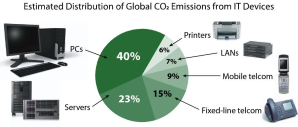Wednesday, December 5, 2012
Cloud Washing: Slapping Lipstick on a Pig!
Recently, I was having a conversation with my colleague, Brian Lenane, Program Manager with SRA International about what’s going on with cloud computing offerings. He related to me how customers are confused with all the “Cloud Washing” going on. Truthfully, if I didn’t know what’s going on, I’d be confused, too. So many companies have called themselves cloud providers when they are nowhere near the cloud. I told him “Thanks, that will be my next blog.” Unfortunately, that was back in September 2012. I found myself transitioning from job to consulting via my personal company, VerdeSol LLC. Being laid off during the holiday seasons seems to be a theme for me in 2011 and 2012, but the beat goes on. I am, however, currently on the market for Cloud Solution Sales, Channel Relationship Management, and Business Development. If you, or someone you know, needs someone like me, look me up.
Cloud Washing Defined
So what is this so called “Cloud Washing”? Marketing people seem to latch onto the cloud to get attention. If you are not savvy to the cloud hype cycle, that strategy will work on you. Because the definition of the cloud is sometimes unclear, the marketing departments tend to call everything the “Cloud”. In my humble, but accurate opinion, the cloud is Information Technology Services delivered exactly like a utility. It doesn’t matter if it is Software as a Service (SaaS), Infrastructure as a Service (IaaS), or Information Technology as a Service (ITaaS), it must be delivered like Telecom, or Heating and Air Conditioning. I will even go a step further, and lump Managed Services Provider (MSP) into the mix. Unfortunately, we have project-based IT and Software Development companies slapping the cloud onto existing products and services.
If I replace my email with Google Apps, Exchange Online or Office 365, I will eliminate Microsoft Exchange, SQL Server, Windows Server 2012, and possibly VMware and the engineers that go with them. That is what we call a “No Brainer”. I want to configure, virtualize, and scale Exchange, like I want to poke my finger in my eye or kiss that pig with lipstick.
Beware!
If you find yourself paying the same rates or higher than traditional IT costs, you probably have a pig with lipstick. Your cloud fees should be one third to one half the cost of traditional IT. Cloud services should have a significant savings compared to hardware, software, and salary costs you pay now. You should NOT be buying hardware to get your cloud service projects off the ground. If you are, you are probably building the pig’s cloud service for the future. Now you will have to pay a fee for numbers of users when it comes to software licensing, but that’s to be expected. Cloud Solution Providers should have their systems baked, and ready for consumption. The order process should be smooth and fluid. If you find them writing a Statement of Work that looks like a project, start asking questions. In addition, they should be able to provide Service Level Agreements for all of their services.
Another thing to be greatly concerned about are data centers with fancy buildings and gear, who sell real estate in their data center, and have decided to add Cloud Solutions as an afterthought because they figured out they can make more margin. Make sure they offer Cloud Security, and Cloud Back Up. I have spent a lot of time evaluating, offering, and selling data center space for the last decade. Many only offer cage space, racks, services, ping, power, and pipe. They leave the rest to you. Well times have changed. Companies are burdened with certifications and compliance, which requires them extensive expertise. If you want to be a true cloud provider in 2013, you need to have Cloud Security, Cloud Back Up, and Disaster Recovery built into your cloud service. Otherwise you are not securing the cloud. PERIOD.
Here is a list of Certifications and Compliance designations your cloud provider should meet or exceed:
• FFIEC (FDIC)
• Gramm-Leach-Bliley Act (GLBA)
• Sorbanes Oxley Act (SOX)
• National Credit Union Association (NCUA)
• Payment Card Industry (PCI)
• FISMA (Department of Defense)
• FEDRAMP (General Services Administration)
• HIPAA
• SAS 70 Compliance
• ISO 27001
• SSAE 16 Certified
Keep in mind each certification may be designed for a specific industry like banking, healthcare, and government. But these are areas to start valid discussions. In addition, passing a certification exam does not guaranty success. The cloud provider should be able to show past performance, and have case studies, and testimonials.
In short, your cloud services should be easy to acquire, easy to implement, and safe and secure. So beware of the charlatans, be smart, and come on in. The cloud is fine.
Wednesday, January 25, 2012
Disruptive Technology from the Desktop to the Data Center
According to Wikipedia, a disruptive technology or disruptive innovation is an innovation that helps create a new market and value network, and eventually goes on to disrupt an existing market and value network (over a few years or decades), displacing an earlier technology. The term is used in business and technology literature to describe innovations that improve a product or service in ways that the market does not expect, typically first by designing for a different set of consumers in the new market and later by lowering prices in the existing market. Virtualization and software design have been the main drivers in the development of disruptive innovations in hardware.
From the Desktop…
One of the main concerns at the desktop level is the need for powerful, yet efficient endpoints, but desktop virtualization rapidly changed the landscape. The endpoints can be anything you want these days; including, desktop pc, tablet, smartphone, or thin client. The dream of desktop virtualization has not been fully realized until now with V3 Systems. In the past, customers were punished for attempting to use thin clients and desktop virtualization (VDI), due to limitations in network, storage and computing capabilities. Most VDI performance made you feel like you were using dial-up. V3 Systems offers an innovative server appliance that hosts 50-400 high-performance virtual desktops in a 1U or 2U form factor. The simplicity of their high-density solution, combined with V3’s optimized technologies and management tools, allows you to easily and affordably scale into the thousands.
Imagine having to architect a VDI solution with the traditional and complex server and SAN based architecture. That project will need at least four separate specializations in network, server, virtualization, and storage. In addition, you would need copious amounts of time to implement. Then here comes V3 Systems with an all-in-one simple appliance you can plug and play into an existing environment, or create a new one from scratch. You can have 400 people up and running in a matter of a couple hours verses a couple weeks. V3 boasts that its solution is 2x to 8x faster than existing desktops. What about VMware, Citrix, Redhat, and Microsoft? It doesn’t really matter, because V3 Systems rocks them all.
The CEO, Peter Bookman and his team of merry snowboarders up in Salt Lake City, UT got a good thing going. They work hard and they play hard. http://www.v3sys.com
…To the Data Center
What high density, low powered servers uses ¼ the power and 1/6 the space of today’s best in class volume server without requiring any modifications to existing software. In the data center we have seen some awesome things happening at the server level, but nothing as extreme as SeaMicro. Imagine squeezing 768 processors in a 10 RU Rack. How is that even possible? Well, they’ve done it. I heard through the grapevine from one of my buddies at EMC that SeaMicro is being installed at some secretive government agencies, which will not be named. If DOD and the Intel community like them, they must be hot stuff. So hot I had to look them up myself.
Volume servers consume more than 1% of the total electricity used in the United States—More than $3 Billion dollars each year. Over the last six years, the power consumed by volume servers more than doubled. For companies in the data center, power consumption is the largest Operating Expense for often accounting for more than 30% of Op EX. In fact, research has shown that over a volume server’s lifetime the cost of power exceeds its purchase price.
SeaMicro has identified the primary drivers underlying the power inefficiencies in volume servers and has systematically rectified these shortcomings. The result is a small form factor server that uses one-quarter of the power and requires only one-quarter of the space used for traditional servers. SeaMicro servers are plug and play—they require no changes to software operating systems, applications, or management infrastructure.
Over the past 10 years, the data center has undergone a sea change in size and scope, including dramatic changes in the demand for compute, the type of compute required, and the economics of operation. Scale out replaced scale up, and the Cloud became the home of many business services and a source of on-demand compute. Despite these changes, the server has remained architecturally unchanged. Server manufacturers made no accommodation for the new and different workloads and traffic patterns despite the highly specialized workloads that rose to dominance in the data center. This mismatch between specialized workloads and generalist servers is an underlying cause of the power consumption issue in the data center.
SeaMicro is a small company led by CEO, Andrew Feldman, that may still take the typical start-up foozeball break, but it's at the leading edge of a trend that's bringing innovation back to the high-volume server market. To me that is very exciting, since I haven’t seen a foozeball table in the office in a decade. http://www.seamicro.com
Tuesday, December 6, 2011
Unsexy Software That Works
One of the chief concerns among CIOs is finding energy efficient and economically efficient solutions with a rapid ROI and low TCO. I blog about energy efficient computing from the desktop to the data center, from hardware to software, from the network to the virtual cloud. Today I’m taking a look at solutions that are not sexy, but seem to work very efficiently and very economically.
Have you ever opened a new laptop or desktop fresh out of the box preloaded with tons of software you don’t need or ever use, and it can take up to 5 minutes for your PC to boot? Well, some unique companies have come up with a solution to get rid of that for you. Soluto, the Anti-Frustration Software, can help consumers for free. This free download can heal application crashes, lighten your web browser, and chop your boot time down significantly.
But let’s say you want to take that type of technology enterprise-wide, and that’s when you’ll want to take a look at Ziften Technologies’, Enterprise Efficiency Software solution. Imagine that boot problem on a large scale, or perhaps miscellaneous software running, but not being utilized. I call that software cholesterol, applications taking up resources, but not actually being used. According to Ziften, there is little to no focus on how to efficiently use resources on endpoints to achieve business goals.
How about enterprise energy management? In the past, IT Management and Facilities Management remained separated on this all important issue. One company, JouleX, has figured out a way to consolidate management of mechanical engineering and the total ICT infrastructure into one solution. JouleX allows you to generate reports, utilization, costs, savings and carbon emissions from data aggregated across your enterprise, data centers and facilities systems. You can reduce energy costs by monitoring, analyzing and controlling energy usage and utilization of all network connected devices and systems without the use of agents.
The least sexy software solution is PC Power Management. When it comes to Green ICT, I believe PC Power Management is the first solution you should try. I don’t care if it is Verdiem, 1E Corporation, BigFix, Faronics, or EnviProt everyone should start here. Why? Because you can reduce energy consumption by at least 40% by turning enterprise-wide PCs off evenings, weekends, or when they simply are not in use. This is the ultimate rapid return on investment with the lowest total cost of ownership, while running silently in the background. 1E Corporation seems to scale higher than most and they also provide server power management. While there are over 20 providers of PC Power Management, I will focus on a little known company called EnviProt. EnviProt got my attention based on their price point and a study they did at UC Berkeley. As far as I know, they have the lowest price point, but don’t quote me.
And last, but not least Green Printing Solutions. Would you like to reduce paper and toner usage? My personal favorite is Preton, which reduces toner usage by up to 70%, while maintaining print quality. In addition, it provides print management protocols and user/printer reports. The main reason it is my favorite is because of its pixel-optimizer technology. I’ve never seen anything like it, and I do not know of any other vendor coming close to it. Now I’ve been accused of sounding like all typical software salesman when I said, “I’ve never seen anything like it” but that’s the truth. I won’t mention any names, but it was a buyer at a prominent technology sales company from Canada that focused on Green IT Solutions, but either my delivery failed or the sex appeal of toner reducing software was just not potent enough to generate interest.
I’m not going to throw that company under the bus because I think they are an awesome company. But they are not alone. Preton was partially evaluated by the Federal Governments’ Green Products Compilation via NASA. Unfortunately they evaluated it without actually loading the software. Now I don’t know about you, but if you’re going to write a report about software, you may want to actually install it and use it. By the way, I never got a copy of the report.
Now I believe this technology is a game changer. Imagine reducing your toner budget by up to 70%. So I challenge anyone to prove me wrong. Find me a Green Printing Solution that comes close to Preton. Order a FREE Trial!
The solutions I have mentioned in this blog are not appearing to be sexy, but they are, and they get the job done. Most of these solutions have been tried out by reputable companies, but have been shoved to the side by more strategic projects like desktop virtualization, data center consolidation, and cloud computing. While those strategic projects are important, except for cloud computing, they are very costly to implement. To me, the low hanging fruit is sexy.
So once you finish those costly projects use the savings to go unsexy with energy efficient software solutions for the enterprise. Contrary to popular belief, there are more efficiency opportunities throughout the desktop enterprise than there is in the data center.
Tuesday, September 6, 2011
The Four Pillars of Green IT!
The Four Pillars of Green IT!
How governments and corporations can become more energy efficient in IT!
Many organizations are now coming into focus with Green IT. We have moved away from the original idea that all computing is Green because it is all online or inside a computer. Just because it is paperless, doesn’t mean there is no room for improvement on environmental and energy efficiency. Believe it or not, three years ago, I heard this from information technology engineers when they queried me about Green IT. Green IT is energy efficient computing from the desktop to the data center, from hardware to software, from the network to the virtual cloud. There are four core areas of competency, all equally important. I will construct the pillars in order of importance, based on my own beliefs.
Pillar #1 – Carbon Accounting & Management
You will hear this statement used over and over incorrectly, but for this purpose, it is correct. “You cannot improve on what you cannot measure.” Compliance issues and environmental key performance indicators dictate that organizations must measure their carbon footprint. As corporations look to gain market share I their vertical market, it is becoming increasingly important to look good on the Dow Jones Sustainability Index, Global 1000 Sustainability Index, and many others…
- 2011 Global 100
- Dow Jones Sustainability Index
- Carbon Disclosure Project
- Global Reporting Initiative
- Global 1000 Sustainable Performance Leaders
Pillar #2 – Cloud Computing | Consumerization of IT
Many organizations have not fully realized the benefits of Cloud Computing to an organization. There are several reasons for this, including: job security, trust, hype, and past performance. Many IT executives are wondering what will happen to all the IT jobs within their organization. I say, repurpose the IT staff for more strategic work besides break/fix maintenance and email. Not trusting the service provider is quite understandable, but just like a good employment search, you must do a good provider search. The one good thing about a reputable cloud service provider is the Service Level Agreements (SLAs). If your in-house IT staff screws it up, you have to pay their salary until they fix it, unless they cannot fix it. The consequences of firing someone in this economy are paying unemployment benefits, and paying recruiting costs to replace them. If the service provider gets it wrong they have to agree to the terms of the SLA.
What workloads should be consumed by cloud computing? In my most humble and accurate opinion, email and computers should be consumed by cloud computing. Why on earth would I want to keep my highly paid IT staff working on common workplace services like email and desktop computers, when that type of work can be done more efficiently with a cloud provider? Let’s say that you’re an older organization running Lotus Notes and you want to migrate to Microsoft Exchange, or you just want to manage an existing Microsoft Exchange Platform. Why bother? Move that email to the cloud. Focus on more strategic things.
Computers-as-a-Service (CaaS) is starting to gain ground these days. Bypass the in-house desktop virtualization projects and focus again on more strategic issues. I think we’ve been doing business long enough to know that there are core software programs that everyone uses. In some cases, it is worth paying $100/month per desktop computer for core applications. I remember talking to the world’s largest credit union about break/fix maintenance. They have 60 people dedicated to break/fix maintenance on computers.
EcomNets has developed so Cloud Services in the form of Cloud Documents, Managed Hosting, Managed Storage, and Disaster Recovery in our Danville Green Data Center. http://www.ecomnets.com
Pillar # 3 – Data Center Energy Efficiency
Many organizations start with the data center, which is understandable, but when you offload to the cloud, your data center will have changed slightly. If you work on my cloud initiatives first, you can consolidate your data center, even more. Data Center Consolidation is the most popular area for CIO’s to focus on. There are many reasons:
- Data Centers Design has become more efficient.
- Data Center Energy Consumption has been doubling over the last decade.
- Organizations cannot afford to ignore the expense of the data center.
- Virtualization has promoted more density within the data center.
There are many tools on the market to help data center managers get a handle on data center energy consumption and performance. If you have a data center efficiency project in the works I suggest that you look at Joulex and/or Power Analytics for help. These tools can monitor more than just IT equipment, they can also manage the facilities equipment.
Pillar #4 – Enterprise Energy Efficiency
The Enterprise Energy Efficiency pillar is the most overlooked aspect of Green IT, but has more efficiency gains than any other pillar. The reason for this is based on assumption and appeal. Many IT executives believe that the data center is the biggest carbon producer, and in some cases it that would be correct. In many instances with large organizations, that would be incorrect. PC Power Management can reduce up to 40% of carbon emissions of all IT equipment. Imagine deploying JouleX for the entire enterprise, and it can turn down PCs, Servers, Printers, Network Devices, Copiers, and Phone Systems, which can get you up to a 91% carbon reduction. In addition, we have telework, green printing solutions, and electronic filing solutions, and electronic waste management programs that can increase reduction of carbon footprint.
Thursday, July 7, 2011
Making the case for Green IT!
Every time someone asks me what I do, I tell them, “I’m the Green IT Guy and I help companies and organizations become energy efficient from the desktop to the data center, from hardware to software, from the network to the virtual cloud.” It took me a while to articulate that. For some reason energy efficient computing was not hitting the mark. Sometimes you have to repeat yourself over and over again. IT professionals would snicker and say stuff like, “Isn’t the Internet already Green because it is paperless, and online?” This illustrates how far the industry has gone from the last couple of years. Now Green IT is a little more digestible. Others would say, “That’s just Green Washing, Marketing Hype!” If I can walk into any organization and cut their energy usage, carbon output, and IT expense in half, I don’t see how that could be considered green washing or marketing hype.
I’m going to try to make a case for Green IT to dispel any lingering myths. Industry changes have occurred resulting in Green Regulations such as: Federal mandates (E.O. 13415 , GSA Green Products Compilation), corporate standards (Dow Jones Sustainability Index, Wal-Mart Sustainability Index), state legislation (City of Riverside), and future carbon accounting regulations. Companies have gone from voluntary to mandatory regulations. Investors were a minority, now they have a few sustainability indexes. IT departments once considered Green IT a niche, and now see it as a core part of their business, as they rapidly consolidate their data centers. Finally, upper management is tying the electric bill to the performance evaluation of the CIO, and that’s a good thing.
UPS’s package software eliminated left-hand turns to save $8.4M in gas and 32K tons of CO2 emissions, according to Forrester Research. Sprint ($40B US Telco) achieved dramatic results in just 1 year:
- They retired 127 applications
- Decommissioned 2,200 servers
- Reclaimed 290,000 GB of storage
- Eliminated 75% of printer output
- Saved $20M in annual IT operating expense
- And cut 10,000mt of GHG emissions
It’s no secret that main stream America is virtualizing their data centers. There are some very big companies and federal organizations consolidating data centers. In fact, the federal government illustrates their goals online. They plan to consolidate 800 data centers worldwide, both physical and virtual. The GSA saved $50/PC/year by shutting down PCs during non-business hours. The City of Palo Alto cut carbon footprint by 5% in one year. Here are some companies that have joined the ranks of data center consolidation:
- Amway Global
- Boise
- Charlotte County
- Children’s Hospital Central California
- Chino Unified School District
- City of Boston
- City of Chicago
- City of Pittsburgh
- Defense Contract Management Agency
- Department of Energy
- FICO
- Florida Department of Transportation
I could go on and on about data center consolidation, but there are too many examples. Unless you’ve been living under a rock, data center consolidation has gone main stream. But just in case you have, go to VMware’s case studies. What about Sun’s Openwork program saves 100 hours/year for each of 18,000 employees? This openwork program is a telework program. Employees working from home so they do not pollute the highways. What about handheld devices? UPS avoids $12M per year in capital expenses using handheld devices for package tracking. Can Green IT strengthen the supply chain? I think so. Tablet devices are moving into hospitals. No more wall mounted PC’s.
What I really wanted to say is this: Green IT is a good deal. You should consider it and make your company look good, efficient, and socially responsible. It only takes four simple steps:
- Assess your situation from top to bottom. (Enterprise, Printers, Desktops, Data Centers)
- Execute a Green IT Action Plan
- Realize a greater than 50% reduction in cost, energy consumption, and carbon output.
- Brag about it through press releases, blogs, and social media. (Ask me how.)
The next thing you know, your company will be listed on the Dow Jones Sustainability Index. You came, you conquered, and you lived to tell about it.
Subscribe to:
Posts (Atom)





















